Wai-Fah Chen.The Civil Engineering Handbook
Подождите немного. Документ загружается.


21-12 The Civil Engineering Handbook, Second Edition
evaluated and the dynamic stresses included in representative elements of the embankment are computed
incorporating nonlinear dynamic material properties by using strain-dependent shear modulus and
damping values. Recent work includes the generation of excess pore-water pressure during dynamic
loading and the onset of liquefaction. Both the overall deformations and the stability of the embankment
section are evaluated.
21.4 Treatments to Improve Stability
General Concepts
Selection Basis
Slope treatments can be placed in one of two broad categories:
•Preventive treatments applied to stable, but potentially unstable natural slopes, slopes to be cut,
sidehill fills to be placed, or embankments to be constructed
•Remedial or corrective treatments applied to existing unstable, moving slopes, or to failed slopes
The slope treatment selected is a function of the degree of the hazard and the risk to the public. In
natural slopes these factors are very much related to the form of slope failure (fall, slump, avalanche, or
flow), the identification of which requires evaluation and prediction by an experienced engineering
geologist.
Rating the Hazard and the Risk
Hazard degree relates to the potential failure itself in terms of its possible magnitude and probability of
occurrence. Magnitudes can range from a small displacement and material volume, as is common in
slump slides, to a large displacement and material volume, such as in a massive debris avalanche.
Probability can range from certain to remote. Risk degree relates to the consequences of failure, such as
a small volume of material covering portions of a roadway but not endangering lives, to the high risk
from the failure of an earth dam resulting in the loss of many lives and much property damage. Safe but
economical construction is always the desired result, but the acceptable degree of safety varies with the
degree of hazard and risk. An example of a rating system for hazard and risk is given in Hunt [1984].
Treatment Options
Avoid the High-Risk Hazard
There are natural conditions where slope failure is essentially unpredictable and not preventable by
reasonable means and the consequences are potentially disastrous. It is best to avoid construction in
mountainous terrain subject to massive planar slides or avalanches, slopes in tropical climates subject to
debris avalanches, or slopes subject to liquefaction and flows.
Accept the Failure Hazard
In some cases, low to moderate hazards may be acceptable because postfailure cleanup is less costly than
some stabilization treatment. Examples are partial temporary closure of a roadway, which is often the
approach in underdeveloped countries, or a slide in an open-pit mine where failure is predictable but
prevention is considered uneconomical.
In many cases, failures are self-correcting, and eventually a slope may reach a stable condition or work
back to where failures do not affect construction. An innovation being used in southern California to
protect homes against debris slides, avalanches, and flows is the “A” wall [Hollingsworth and Kovacs, 1981]
illustrated in Fig. 21.10. The purpose of the wall is to deflect moving earth masses away from the building.
Eliminate or Reduce the Hazard
Where failure is essentially predictable and preventable, or is occurring or has occurred and is suitable
for treatment, slope stabilization methods are applied. For low-to-moderate-risk conditions, the approach
can be either to eliminate or to reduce the hazard, depending on comparative economics. For high-risk
© 2003 by CRC Press LLC
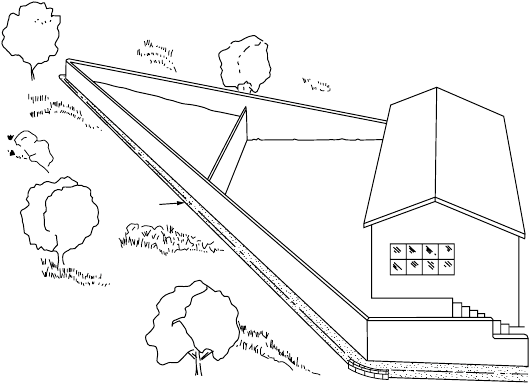
Stability of Slopes 21-13
conditions the hazard should be eliminated. The generally acceptable safety factor determined by stability
analysis can be taken as follows: low risk, FS = 1.3; significant risk, FS = 1.4; high risk, FS = 1.5.
Slope Stabilization
Slope stabilization methods may be placed in five general categories, as follows (Fig. 21.11):
1. Change slope geometry to decrease the driving forces or increase the resisting forces.
2. Control surface water to prevent erosion, and infiltration to reduce seepage forces.
3. Control internal seepage to reduce the driving forces.
4. Increase material strengths to increase resisting forces.
5. Provide retention to increase the resisting forces.
Where slopes are in the process of failing, the time factor must be considered. Time may not be available
for carrying out measures that will eliminate the hazard; therefore, the hazard should be reduced and
perhaps eliminated at a later date. The objective is to arrest the immediate movement. Where possible,
treatments should be performed during the dry season, when movements will not affect remediation
such as breaking horizontal drains.
Changing Slope Geometry
Natural Slope Inclinations
In many cases the natural slope represents the maximum long-term inclination, but there are cases where
the slope is not stable and is moving. The inclination of existing slopes should be noted during field
reconnaissance, since an increase in inclination by cutting may result in failure.
Cut Slopes in Rock
The objective of any cut slope is to form a stable inclination without retention. Controlled blasting
procedures are required in rock masses to avoid excessive rock breakage resulting in extensive fracturing.
Line drilling and presplitting during blasting operations minimize disturbance of the rock face.
Hard masses of igneous or metamorphic rocks, widely jointed, are commonly cut to 1H:4V (76˚)
[Terzaghi, 1962] [Fig. 21.12(a)]. Hard rock masses with joints, shears, or bedding representing major
discontinuities dipping downslope are excavated along the dip of the discontinuity, as shown in
FIGURE 21.10 Typical A-wall layout to deflect debris slides, avalanches, and flows. (Source: Hollingsworth, R., and
Kovacs, G. S. 1981. Soil slumps and debris flows: Prediction and protection. Bul. Assoc. Eng. Geol. 18(1):17–28.)
Level rear yard
Retaining wall
beam
V" drain
Grade
© 2003 by CRC Press LLC
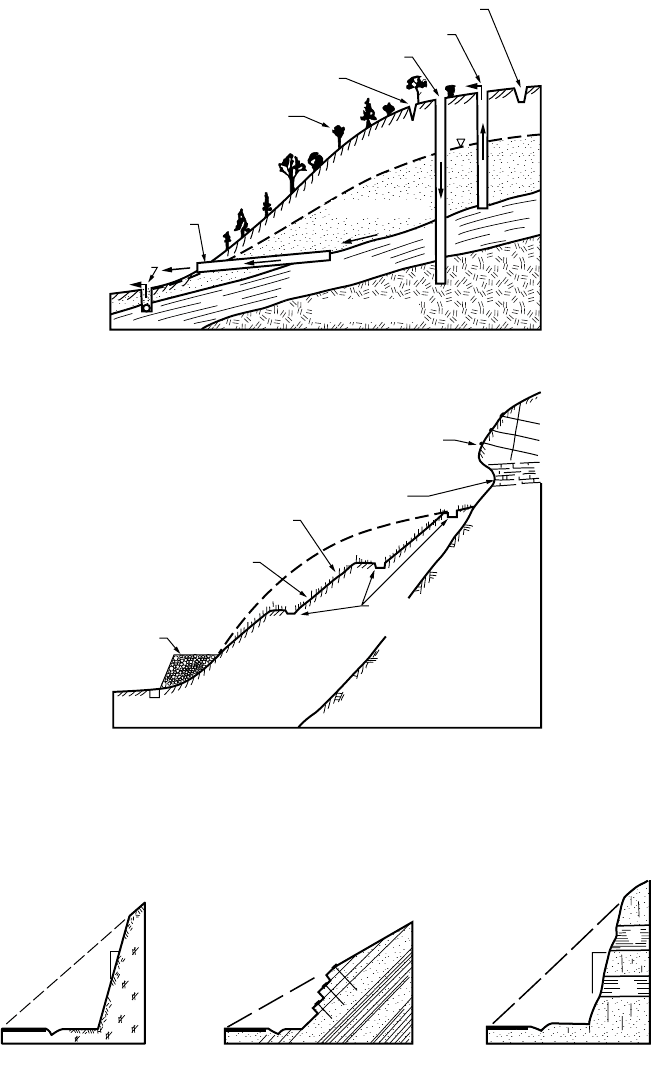
21-14 The Civil Engineering Handbook, Second Edition
FIGURE 21.11 The general methods of slope stabilization: (a) control of seepage forces, (b) reducing the driving
forces and increasing the resisting forces. (Source: Hunt, R. E. 1984. Geotechnical Engineering Investigation Manual.
McGraw-Hill, New York.)
FIGURE 21.12 Ty pical cut slopes in hard rock for a roadway. Leave space at A for storage of block falls and topples
and scale slope of loose blocks. (a) Closely jointed, competent rock. (b) Dipping beds; follow the dip unless excessively
flat, in which case retain with bolts B. (c) Horizontally bedded sandstones and shales; apply gunite to the shales S if
subjected to differential weathering. (Source: Hunt, R. E. 1986. Geotechnical Engineering Techniques and Practices.
McGraw-Hill, New York. Reprinted with permission of McGraw-Hill Book Co.)
Impervious
zone
(a)
(b)
Lined drainage ditch upslope
Pumped wells
Vertical gravity wells
Seal fractures
Maintain slope
vegetation
Subhorizontal
gravity drains
or galleries
Toe
drain
Pervious zone
Phreatic zone
Rock bolts or
cable anchors
Shotcrete or wall
in weak zone
Plant vegetation
Reduce slope
inclination
Soil
Rock
Control runoff with
lined drains
Retain slope
with berm,
buttress,
or wall
1
4
B
4
1
A
(a) (b) (c)
S
S
© 2003 by CRC Press LLC
Stability of Slopes 21-15
Fig. 21.12(b). All material should be removed until the original slope is intercepted. If the dip is too
shallow for economical excavation, slabs can be retained with rock bolts (see “Retention,” later in this
chapter).
Hard sedimentary rocks with bedding dipping vertically or into the face, or horizontally interbedded
hard sandstones and shales [Fig. 21.12(c)], are often cut to 1H:4V, but in the latter case, the shales should
be protected from weathering with shotcrete or gunite to retard differential weathering. Weathered or
closely jointed masses (except clay shales and dipping major discontinuities) require a reduction in
inclination to between 1H:2V to 1H:1V (63˚ to 45˚) depending on conditions, or require some form of
retention. Clay shales, unless interbedded with sandstones, are often excavated to 6H:1V (9.5˚).
Benching has been common practice in high rock cuts but there is disagreement among practitioners
as to its value. Some consider benches to be undesirable because they provide takeoff points for falling
blocks [Chassie and Goughnor, 1976]. To provide for storage they must be of adequate width. Block
storage space should always be provided at the slope toe with adequate shoulder width to protect the
roadway from falls and topples.
Cut Slopes in Soils
Most soil formations are commonly cut to an average inclination of 2H:1V (26˚) but consideration must
be given to seepage forces and other physical and environmental factors to determine if retention is
required. Soil cuts are normally designed with benches, especially for cuts over 25 to 30 ft high. Because
the slope angle between benches may be increased, benches reduce the amount of excavation necessary
to achieve overall lower inclinations. Drains are installed as standard practice along the slopes and the
benches to control runoff, as illustrated in Fig. 21.11(b) and Fig. 21.13.
In soil–rock transition (strong residual soils to weathered rock) such as in Fig. 21.13, cuts are often
excavated to between 1H:2V to 1H:1V (63˚ to 45˚) although potential failure along relict discontinuities
must be considered. Where there is thin soil cover over rock the soil should be removed or retained as
the condition normally will be unstable in cut. Figure 21.13 illustrates an ideal case, often misinterpreted
from test boring data, and not present in the slope. In mountainous terrain all of the formations may
be dipping, as shown on Fig. 21.14, a potentially very unstable condition. In such conditions, downslope
seismic refraction surveys are valuable to define stratigraphy.
Failing Slopes
If a slope is failing and undergoing substantial movement, the removal of material from the head to
reduce the driving forces can be the quickest method of arresting movement, and benching may be
effective in the early stages. Placing material at the toe to form a counterberm increases the resisting
forces. An alternative is to remove debris from the toe and permit failure to occur. Eventually the mass
may naturally attain a stable inclination.
Changing slope geometry to achieve stability once failure has begun usually requires either the removal
of very large volumes or the implementation of other methods. Space is seldom available in critical
situations to permit placement of material at the toe, since very large volumes normally are required. As
will be discussed, subhorizontal drains are often a very effective intermediate solution.
Surface Water Control
Purpose
Surface water is controlled to eliminate or reduce infiltration and to provide erosion protection. External
measures are generally effective, however, only if the slope is stable and there is no internal source of
water to cause excessive seepage forces.
Infiltration and Erosion Protection
Planting the slope with thick, fast-growing native vegetation strengthens the shallow soils with root
systems and discourages desiccation, which causes fissuring. Not all vegetation works equally well, and
© 2003 by CRC Press LLC
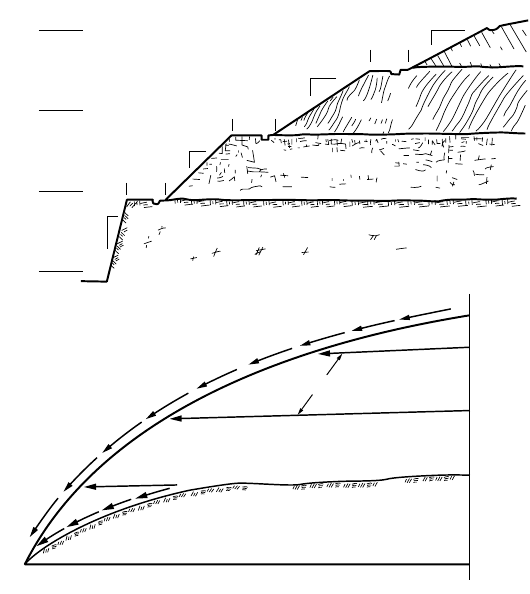
21-16 The Civil Engineering Handbook, Second Edition
selection requires experience. In the Los Angeles area of California, for example, Algerian ivy has been
found to be quite effective in stabilizing steep slopes [Sunset, 1978]. Newly cut slopes should be imme-
diately planted and seeded. Burlap bags or sprayed mulch helps increase growth rate and provide
protection against erosion during early growth stages. In addition to plantings, erosion protection along
the slope can be achieved with wattling bundles, as illustrated in Fig. 21.15.
Sealing cracks and fissures with asphalt or soil cement will reduce infiltration but will not stabilize a
moving slope since the cracks will continue to open. Grading a moving area results in filling cracks with
soil, which helps reduce infiltration.
Surface Drainage Systems
Cut slopes should be protected with interceptor drains installed along the crest of the cut, along benches,
and along the toe (Figs. 21.11 and 21.13). On long cuts the interceptors are connected to downslope
collectors [Fig. 21.13(b)]. All drains should be lined with nonerodible materials, free of cracks or other
openings, and designed to direct all concentrated runoff to discharge offslope.
With failing slopes, installation of an interceptor along the crest beyond the head of the slide area will
reduce runoff into the slide. But the interceptor is a temporary expedient, since in time it may break up
and cease to function as the slide disturbance progresses upslope.
FIGURE 21.13 Benching a cut slope. (a) Typical section with drains located at D. Slope in weathered rock varies
with rock quality; in saprolite, varies with orientation of foliations. Attempt is made to place benches on contact
between material types. (b) General scheme to control runoff and drainage shown in face view. (Source: Hunt, R. E.
1986. Geotechnical Engineering Techniques and Practices. McGraw-Hill, New York. Reprinted with permission of
McGraw-Hill Book Co.)
Depth, m
0
10
20
4
1
1
1.5
1
1
1
2
D
D
D
Residuum
Saprolite
Weathered rock
Unweathered, sound rock
(a)
(b)
Longitudinal drains at ≈ 2%
Interceptor drain along crest
5 m
D
5 m
4 m
30
© 2003 by CRC Press LLC
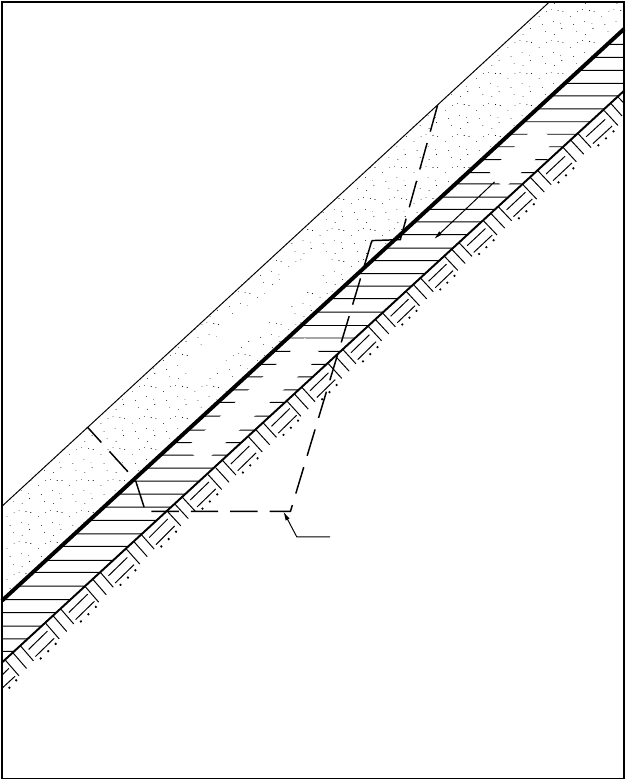
Stability of Slopes 21-17
Internal Seepage Control
General
Internal drainage systems are installed to lower the piezometric level below the potential or existing sliding
surface. Selection of the drainage method is based on consideration of the geologic materials, structure,
and groundwater conditions (static, perched, or artesian), and the location of the phreatic surface.
As the drains are installed, the piezometric head is monitored by piezometers and the efficiency of the
drains is evaluated. The season of the year and the potential for increased flow during wet seasons must
be considered, and if piezometric levels are observed to rise to dangerous values (as determined by stability
analysis, or from monitoring slope movements), the installation of additional drains is required.
Cut Slopes
Systems to relieve seepage forces in cut slopes are seldom installed in practice, but they should be
considered more frequently, since there are many conditions where they would aid significantly in
maintaining stability.
FIGURE 21.14 Slope conditions common along steep slopes in mountainous terrain.
Moderately to Lightly Fractured Rock
Highway Cut
Highly Fractured Rock
Residual or Colluvial Soil
seepage
© 2003 by CRC Press LLC
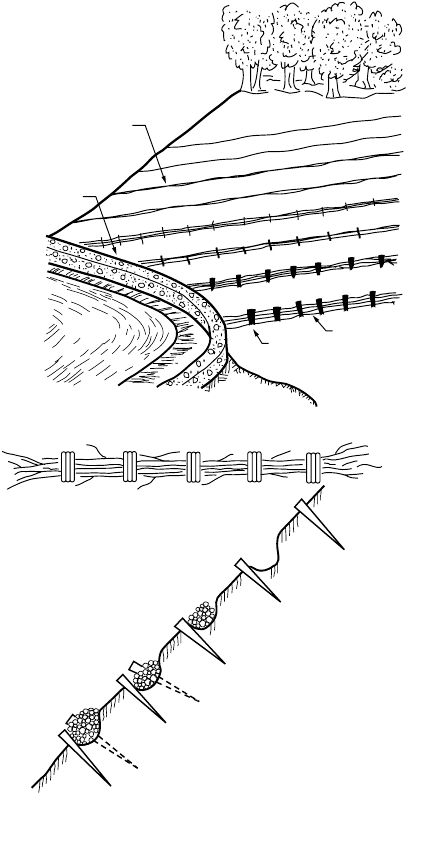
21-18 The Civil Engineering Handbook, Second Edition
Failing Slopes
The relief of seepage pressures is often the most expedient means of stabilizing a moving mass. The
primary problem is that, as mass movement continues, the drains will be cut off and cease to function;
therefore, it is often necessary to install the drains in stages over a period of time. Installation must be
planned and performed with care, since the use of water during drilling could possibly trigger a total
failure.
FIGURE 21.15 Erosion protection by installation of wattling bundles along contours of slope face. (a) Contoured
wattling on slope face. (b) Sequence of operations for installing wattling on slope face. Work starts at bottom of cut
or fill with each contour line proceeding from step 1 through 5. Cigar-shaped bundles of live brush of species which
root are buried and staked along slope. They eventually root and become part of the permanent slope cover. (After
Gray et. al., 1980. Adapted with the permission of the American Society of Civil Engineers.)
Contoured
wattling
rows
wattling
bundles
Stakes
Road
Low
wall
Wattling bundle of five brush with butts
alternating 8-10 in dia., tied 12-15 in oc
1. Stake on
contour
2. Trench above stake
1/2 bundle diameter
3. Place bundles
in trench
4. Add stakes through and
below bundles
5. Cover wattling with soil
and tamp firmly
(a)
(b)
© 2003 by CRC Press LLC
Stability of Slopes 21-19
Methods
Deep wells have been used to stabilize many deep-seated slide masses, but they are costly since continuous
or frequent pumping is required. Check valves normally are installed so that when the water level rises,
pumping begins. Deep wells are most effective if installed in relatively free-draining material below the
failing mass.
Vertical gravity drains are useful in perched water-table conditions where an impervious stratum
overlies an open, free-draining stratum with a lower piezometric level. The drains permit seepage by
gravity through the confining stratum and thus relieve hydrostatic pressures. Clay strata over granular
soils, or clays or shales over open-jointed rock, offer favorable conditions for gravity drains where a
perched water table exists.
Subhorizontal drains are one of the most effective methods to improve stability of a cut slope, or to
stabilize a failing slope. Installed at a slight angle upslope to penetrate the phreatic zone and permit
gravity flow, they usually consist of perforated pipe, 2 in. diameter or larger, forced into a predrilled hole
of slightly larger diameter than the pipe. Horizontal drains have been installed to lengths of more than
300 ft. Spacing depends on the type of material being drained; fine-grained soils may require spacing as
close as 10 to 30 ft, whereas for more permeable materials, 30 to 50 ft may suffice.
Drainage galleries are very effective for draining large moving masses but their installation is difficult
and costly. They are used mostly in rock masses where roof support is less of a problem than in soils.
Installed below the failure zone to be effective, they are often backfilled with stone. Vertical holes drilled
into the galleries from above provide for drainage from the failure zone into the galleries.
Interceptor trench drains can be installed upslope to intercept groundwater flowing into a cut or sliding
mass, but they must be sufficiently deep. Perforated pipe is laid in the trench bottom, embedded in sand,
and covered with free-draining material, then sealed at the surface. Interceptor trench drains are generally
not practical on steep, heavily vegetated slopes because installation of the drains and access roads requires
stripping the vegetation, which will tend to decrease stability.
Relief trenches relieve pore pressures at the slope toe. They are relatively simple to install. Excavation
should be made in sections and quickly backfilled with stone so as not to reduce the slope stability and
possibly cause a total failure. Generally, relief trenches are most effective for small slump slides where
high seepage forces in the toe area are the major cause of instability.
Electroosmosis has been used occasionally to stabilize silts and clayey silts, but the method is relatively
costly, and not a permanent solution unless operation is maintained.
Increased Strength
Chemicals have sometimes been injected to increase soil strength. In a number of instances the injection
of a quicklime slurry into predrilled holes has arrested slope movements as a result of the strength increase
from chemical reaction with clays [Handy and Williams, 1967; Broms and Boman, 1979]. Strength
increase in saltwater clays, however, was found to be low.
Resistance along an existing or potential failure surface can be increased with drilled piers [Oakland
and Chameau, 1989; Lippomann, 1989], shear pins (reinforced concrete dowels), or stone columns. In
the latter case the increased resistance is obtained from a significantly higher friction angle obtained in
the stone along its width intercepting the failure surface.
Sidehill Fills
Failures
Construction of a sidehill embankment using slow-draining materials can be expected to block natural
drainage and evaporation. As seepage pressures increase, particularly at the toe (as shown in Fig. 21.16),
the embankment strains and concentric tension cracks form. The movements develop finally into a
rotational failure. Fills placed on moderately steep to steep slopes of residual or colluvial soils, in particular,
© 2003 by CRC Press LLC
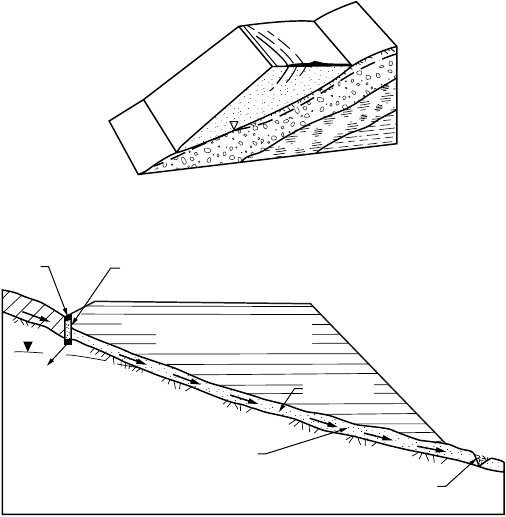
21-20 The Civil Engineering Handbook, Second Edition
are prone to be unstable unless seepage is properly controlled, or the embankment is supported by a
retaining structure.
Preventive Treatments
Interceptor trench drains should be installed along the upslope side of all sidehill fills as standard practice
to intercept flow, as shown in Fig. 21.17. Perforated pipe is laid in the trench bottom, embedded in sand,
covered by free-draining materials, and then sealed at the surface. Surface flow is collected in open drains
and all discharge, including that from the trench drains, is directed away from the fill area.
Where anticipated flows are low to moderate, transverse drains extending downslope and connecting
with the interceptor ditches upslope, parallel to the roadway, may provide adequate subfill drainage.
Wherever either the fill or the natural soils are slow-draining, however, a free-draining blanket should
be installed over the entire area between the fill and the natural slope materials to relieve seepage pressures
from shallow groundwater conditions (Fig. 21.17). It is prudent to strip potentially unstable upper soils,
which are often creeping on moderately steep to steep slopes, to a depth where stronger soils are
encountered. Stepped excavations improve stability. Discharge should be collected at the low point of
the fill and drained downslope in a manner that will provide erosion protection.
Retaining structures may be economical on steep slopes that continue for some distance beyond the
fill, if stability is uncertain.
Corrective Treatments
If movement downslope has begun in a slow initial failure stage, subhorizontal drains may be adequate
to stabilize the embankment if closely spaced. They should be installed during the dry season, if practical,
since the use of water to drill holes during the wet season may accelerate total failure. An alternative is
FIGURE 21.16 Early failure stage in sidehill fill as concentric cracks form in the pavement.
FIGURE 21.17 Proper drainage provisions for a sidehill fill A constructed of relatively impervious materials over
relatively impervious natural soils S subject to surface creep. Upper soils are stripped and replaced with free-draining
blanket B. Interceptor trench drain C installed and sealed with lined ditch D. Groundwater discharge collected at
low point E and directed downslope. (Source: Hunt, R. E. 1986. Geotechnical Engineering Techniques and Practices.
McGraw-Hill, New York. Reprinted with permission of McGraw-Hill Book Co.)
Ditch
Interceptor trench drain, sealed
Embankment of relatively
impervious materials
Free-draining blanket or
traverse drains
Discharge collected at low point
and directed downslope
Seepage
© 2003 by CRC Press LLC

Stability of Slopes 21-21
to retain the fill with an anchored curtain wall (Fig. 21.18). After total failure, the most practical solutions
are either reconstruction of the embankment with proper drainage, or retention with a wall.
Retention
Rock Slopes
Various methods of retaining hard rock slopes are illustrated in Fig. 21.19. They can be described briefly
as follows.
•Concrete pedestals are used to support overhangs, where their removal is not practical because of
danger to existing construction downslope [Fig. 21.19(a)].
•Rock bolts are used to reinforce jointed rock masses or slabs on a sloping surface [Fig. 21.19(b)].
Ordinary or temporary rock bolts, and fully grouted or permanent rock bolts are described by
Lang [1972].
•Concrete straps and rock bolts are used to support loose or soft rock zones or to reduce the number
of bolts [Fig. 21.19(c)].
•Cable anchors are used to reinforce thick rock masses [Fig. 21.19(d)]. The reinforcement of a
single block by bolts or cables is shown in Fig. 21.20.
Shotcrete, when applied to rock slopes, usually consists of a wet-mix mortar with aggregate as large as
2 cm (3/4 in.) which is projected by air jet directly onto the slope face. The force of the jet compacts the
mortar in place, bonding it to the rock, which first must be cleaned of loose particles and loose blocks.
FIGURE 21.18 Various types of retaining walls: (a) rock-filled buttress; (b) gabion wall; (c) crib wall; (d) reinforced
earth wall; (e) concrete gravity wall; (f
) concrete-reinforced semigravity wall; (g) cantilever wall; (h) counterfort
wall; (i) anchored curtain wall. (Source: Hunt, R. E. 1986. Geotechnical Engineering Techniques and Practices. McGraw-
Hill, New York. Reprinted with permission of McGraw-Hill Book Co.)
(a)
Metal strips
Panels
(d)
(g) (h) (i)
(e) (f)
(b) (c)
Stretchers
Headers
Backfill
Random
backfill
Compacted
select
fill
Select
backfill
Select
backfill
Select
backfill
© 2003 by CRC Press LLC
